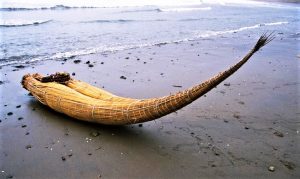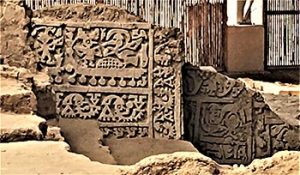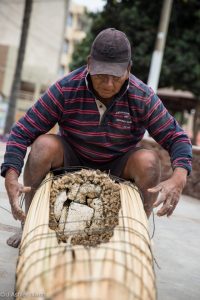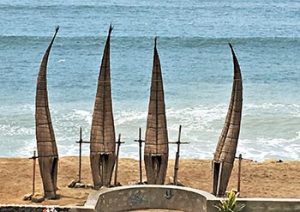
by George Fery
Traveling on the dry wind-swept northern coast of Peru, beside spectacular landscape, one finds interesting ways of how people make a living. That’s how a strange little raft made of reeds used by fishermen in Huanchaco, raised both eyebrows and curiosity. The large town is located eight miles north of Trujillo and 304 miles from the capital Lima, on the Pan American highway.
 What a curious contraption, unlike anything one might expect for the task. And what do you say they call it? Caballito de Totora; the name translates as “Little Horse of Totora.” It seems that we have both an unusual contraption and a contradiction, because the horse, caballo or caballito for little horse in Spanish, did not exist before the arrival of the Europeans in the Americas.
What a curious contraption, unlike anything one might expect for the task. And what do you say they call it? Caballito de Totora; the name translates as “Little Horse of Totora.” It seems that we have both an unusual contraption and a contradiction, because the horse, caballo or caballito for little horse in Spanish, did not exist before the arrival of the Europeans in the Americas.
 How was it called in the past we don’t know, but their use is recorded over thousands of years, from ceramics of the great Moche and Chimu, and other cultures centuries before, whose fishermen adopted the very same reed raft to harvest fish. Representation of the raft in ceramics and carved in adobe walls at Tucume, a pre-Columbian site, are virtually identical to the ones used today. The nodules shown below the raft, represent waves.
How was it called in the past we don’t know, but their use is recorded over thousands of years, from ceramics of the great Moche and Chimu, and other cultures centuries before, whose fishermen adopted the very same reed raft to harvest fish. Representation of the raft in ceramics and carved in adobe walls at Tucume, a pre-Columbian site, are virtually identical to the ones used today. The nodules shown below the raft, represent waves.
Reed rafts are among the oldest river and coastal modes of transport. Remains were found on the Failaka Island in Kuwait, dated 7,000 years ago. In Egypt, rafts were built of papyrus reeds (cyperus papyrus), a close family to the Huanchaco reeds, that were widely cultivated on the Nile’s banks and its Delta, date back to 4000BC. Reeds used for raft or boat building are found in the archaeological record throughout the world.
In the Americas, the material used to build rafts in the past and today, is the totora reed, a plant that grows in swamps along the northern coast of Peru, such as at the Huanchaco ecological reserve in the sand dunes north of town, locally called Humedades de Huanchaco.
The totora plant scientific name is Schoenoplectus californicus subsp. tatora; a mouthful isn’t? The plant is found in South America, on the shores of Lake Titicaca at 12,707 feet in Bolivia, as well as on the middle coast of Peru and, of all places, on Easter Island in the Pacific. How did it find its way there so far from south America? Birds may be the culprits; they eat seeds at one place and drop them at another.
The plant can reach a height of 20 feet, but is more commonly 13-15 feet high, that’s about the average length of a caballito de totora, the raft local name.
 It is made of two bundles of totora dry reeds tied up together with double loop ropes. Today pieces of polystyrene are built into each of the twin bundles for added buoyancy, and nylon rope replace totora vines to tie up the bundles. It takes but a few hours to make a caballito, and the material used in their fabrication can rapidly and economically be replaced.
It is made of two bundles of totora dry reeds tied up together with double loop ropes. Today pieces of polystyrene are built into each of the twin bundles for added buoyancy, and nylon rope replace totora vines to tie up the bundles. It takes but a few hours to make a caballito, and the material used in their fabrication can rapidly and economically be replaced.
The relatively light weight of the raft at about 35+ pounds, allows it to be carried on a man’s shoulder. There is an argument about the caballito: is it a boat or a raft?
The distinction between the two is that the boat is usually waterproofed with some sort of tar, while the raft is not; so, our caballito is a raft! Could it perhaps be considered a precursor to today’s surf and paddle board?, Ooops, here is another argument.
The caballito de totora is made to get past the surf and waves in the ocean, not ride them. The raft rides the swells of the Pacific beautifully thanks to its curved pointed upward bow, in the shape of an elephant tusk. Its pre-Columbian design helps cut through the surf and reach deeper water where bigger fish are found.
A caballito rider does not go into the raft because there is no “into.” They typically ride seated or kneeling in the rectangular rear stern or straddling the raft with their legs dangling overboard. Out to sea they will avoid having their feet out, since sea lions in the area may be tempted.
When they get a large catch, they will store the fish in plastic bags with the nets, on the flat stern while riding on the body of the caballito. For propulsion, the rider carries a bamboo stalk about 8 to 9ft long split in half over its length, 7-9 inches wide, that’s the paddle; it also helps the rider keep lateral balance on the waves.
Fishermen cannot go far off the coast given the limitation of their craft. They cast their nets, between two ore more caballitos, about two to four miles off shore. The nets are weighted and held by floats. After setting the nets they go their separate ways with each man dropping traps for lobster.
On a very good day the catch may be up to 80+ pounds, but more often than not the catch does not exceed about 25-35 pounds. Beside two or three lobsters perhaps, the mix of fish may include sardines, mullet, sea bass, calamari and others. The weight of the catch is limited by the craft structure in addition to the rider’s weight.
The waters teem with fish and fishermen aim for medium to large fish that sell quickly on arrival to hotels and restaurants. Commercial and private buyers are waiting on the beach…sometimes with a pod of pelicans in the shallows, since who knows what can drop off the raft?
What is not sold on the beach will be loaded in a hand cart for sale to small restaurants in town. It is a hard way to make a living and is seen as an “old man” occupation by the younger generation.
Tip: lunch on the beach front because the fish of your ceviche surely came right out of a caballito that very same day.
Speaking of ceviche, Peru’s national dish must not to be confused with others that brag about the dish name’s ownership; after all, everyone’s entitled to an opinion. There are many ways to prepare ceviche; type of fish (best is sea bass); other ingredients and spices may vary from one place to another along the coast. But you’ll want to start with a good Pisco Sour, unavoidable in this great country where the drink was born, and what a great drink it is, while waiting overwhelmed by the aroma of delightful food.
Back to our strange contraption. Not so long ago the rafts were seen all along the coast, now they are only found in few places among which is Huanchaco, believed to be the most traditional place, with about 25-30 full time fishermen.
As a rule, a fisherman has two or more caballitos because the reeds soak up water and after a couple of weeks, one needs to stay on shore to dry, propped up against wooden cross bars on the beach, while the other goes to sea.
 Are the caballitos fading into the sunset? In August 2014 an article in the Huanchaco Journal written by William Neuman and Andrea Zarate summed up the situation: yes. There are a number of factors among which is a long breakwater built for port traffic that altered the currents in the bay and brought significant environmental degradation that damaged the totora reed tracts and narrowed the beach. There were over 200 tracts in 2011, there are less than 120 today. As major as it sounds, it’s still a minor factor.
Are the caballitos fading into the sunset? In August 2014 an article in the Huanchaco Journal written by William Neuman and Andrea Zarate summed up the situation: yes. There are a number of factors among which is a long breakwater built for port traffic that altered the currents in the bay and brought significant environmental degradation that damaged the totora reed tracts and narrowed the beach. There were over 200 tracts in 2011, there are less than 120 today. As major as it sounds, it’s still a minor factor.
The major factor is the arrival a few years back of affordable fiberglass and aluminum boats that are safer, can go farther and carry more fish; the caballitos cannot compete. Fishermen today get a significant part of their income giving rides on their caballito to a steady stream of tourists. Younger men will double as surf instructors on theirs.
Alas, the young generation can get a better financial return for their labor working in the hospitality or industrial fishing industries, among other occupation. It seems that the caballitos will, in a not so distant future, be relegated to entertainment for tourists or to museums. Inexorably, their practical use is fading with each sunset.
If You Go:
Freelance writer, researcher, and photographer, Georges Fery (georgefery.com) addresses topics, from history, culture, and beliefs to daily living of ancient and today’s indigenous communities of the Americas. His articles are published online in the U.S. at travelthruhistory.com, popular-archaeology.com, and ancient-origins.net, as well as in the quarterly magazine Ancient American (ancientamerican.com). In the U.K. his articles are found in mexicolore.co.uk.
The author is a fellow of the Institute of Maya Studies instituteofmayastudies.org Miami, FL, and The Royal Geographical Society, London, U.K. rgs.org. As well as a member in good standing of the Maya Exploration Center, Austin, TX mayaexploration.org, the Archaeological Institute of America, Boston, MA archaeological.org, NFAA-Non Fiction Authors Association nonfictionauthrosassociation.com, and the National Museum of the American Indian, Washington, DC. americanindian.si.edu.
Photographs:
- Catch in Hand – ©Sergi Reboredo / alamy.com
- The Caballito – ©Willem Proos / willemproos@xs4all.nl
- Tucume – ©georgefery.com
- Polystyrene – ©J. Ashley Nixon / ashleynixon.com
- Drying Up – ©georgefery.com







Leave a Reply
You must be logged in to post a comment.